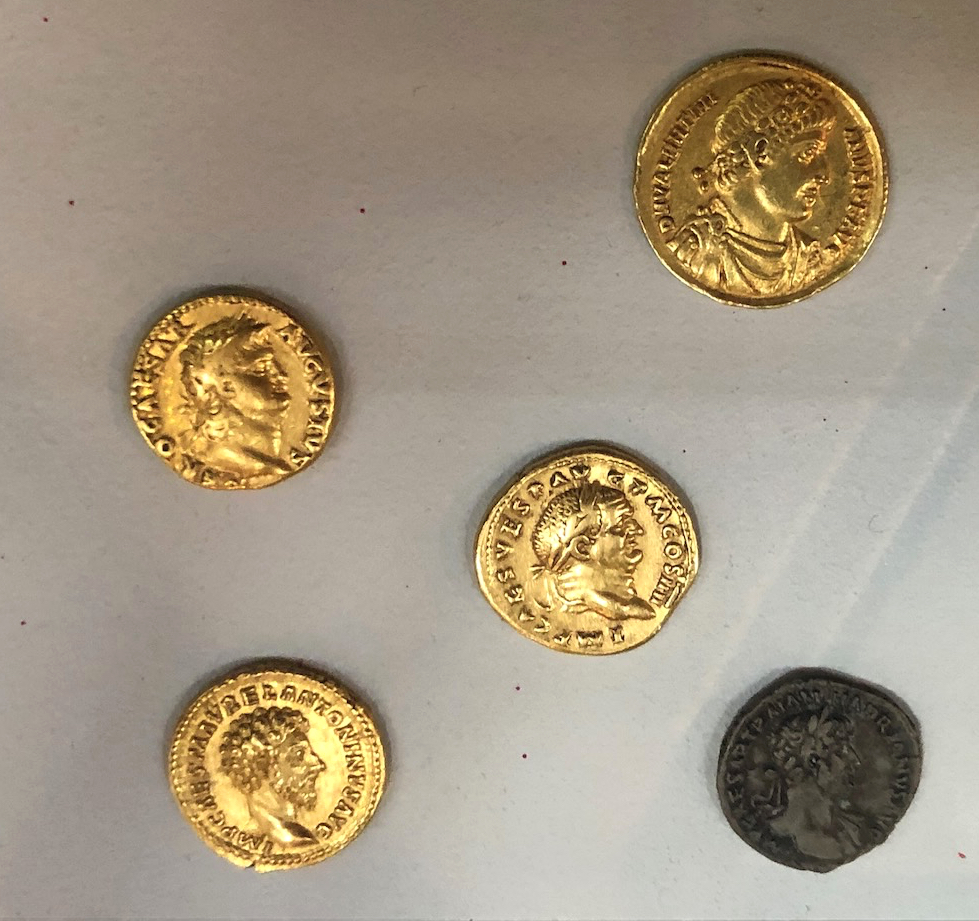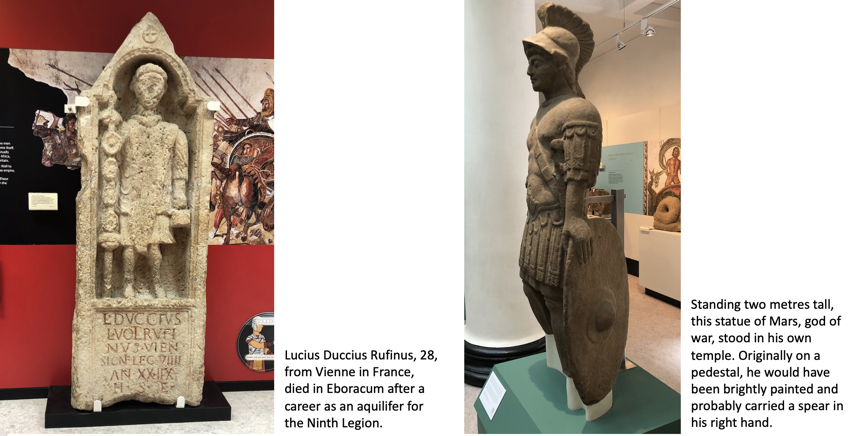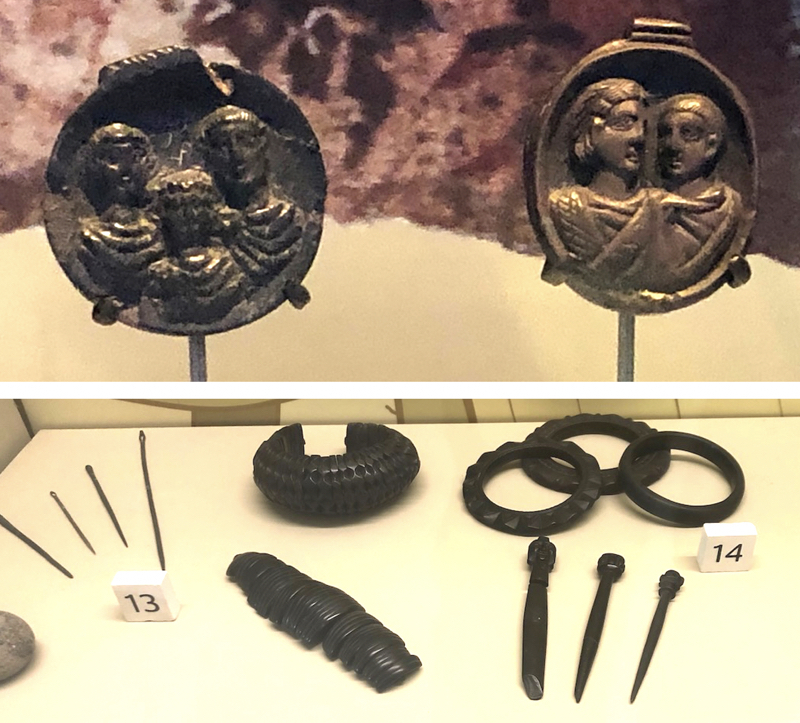 I’ve been in York this weekend for the Eboracum Roman Festival. I’ll be blogging about that next but on the Friday before I indulged in some historical tourism and visited the Yorkshire Museum.
I’ve been in York this weekend for the Eboracum Roman Festival. I’ll be blogging about that next but on the Friday before I indulged in some historical tourism and visited the Yorkshire Museum.
Eboracum was a fort in the Roman province of Britannia and, at its height, the largest town in northern Britain. The site was still occupied after the decline of the Western Roman Empire and ultimately developed into the present-day city York.
Celebrity connections
Emperor Hadrian may well have visited in AD 122 on his way north to plan his wall and he either brought, or sent earlier, the Sixth Legion to replace the existing garrison. Emperor Septimius Severus visited Eboracum in AD 208 and made it his base for campaigning in Scotland. However, he was one of two Roman emperors who died in Eboracum: Severus in AD 211, and Constantius Chlorus in AD 306. Chorus’s son, Constantine (called the Great), was declared emperor in Eboracum. So lots of imperial connection.

Most people would never see the emperor in the flesh but coins circulated his image to the masses. Emperors chose how they wanted to be perceived. Hadrian is bearded – powerful in the spirit of the Greek god Heracles/Hercules. Constantine the Great is clean shaven – a strong military leader. Septimius Severus styles himself on his favourite god, Serapis.
Early years
The Roman conquest of Britain began in AD 43, but they didn’t advance beyond the Humber until the early 70s AD. The Romans called the tribes in the region around York the Brigantes and the Parisii; York may have been on the border between them. At first, the Brigantes held the status of a client kingdom, but when Brigantian leadership changed, they became more hostile to Rome. When that type of thing happens, we know what follows…
Roman General Quintus Petillius Cerialis led the Ninth Legion north from Lincoln across the Humber and in AD 71 constructed a military fortress (castra) on flat ground above the River Ouse near its junction with the River Foss. In the same year, Cerialis was appointed Governor of Britain.
At some time between AD 109 and AD 122 the garrison of the Ninth Legion was replaced by the Sixth Legion. There’s no documented trace of the Ninth Legion after AD 117. Multiple theories abound about its fate. (Have you read Rosemary Sutcliff’s The Eagle of the Ninth?) The Sixth Legion remained in York until the end of Roman occupation about AD 400.
Rapid growth
A legion at full strength at that time numbered some 5,500 men. As with any large army on the doorstep, it provided new trading opportunities for enterprising local people who doubtless flocked to Eboracum to take advantage Nothing new under the sun….
As a result, a permanent civilian settlement grew up around the fortress. By the later 2nd century AD, it had grown exponentially; streets were laid out, public buildings erected and private houses spread out over covering terraces on the steep slopes above the river.
Maturing into a local capital
Eboracum was the major military base in the north of Britain and, following the 3rd century AD division of the province of Britannia, became the capital of northern Britain (Britannia Inferior). By AD 237, Eboracum had been made a colonia, the highest legal status a Roman city could attain, a significant mark of Imperial favour – one of only four in Britain. At around the same time, Eboracum became self-governing with a council made up of prosperous locals, including merchants and veteran soldiers. In AD 296, Britannia Inferior was divided into two provinces of equal status with Eboracum becoming the provincial capital of Britannia Secunda.
As a busy port and a provincial capital Eboracum was a cosmopolitan city with residents from throughout the Roman Empire. As well as the development of social and hospitality businesses, workshops grew up outside the fortress to supply the needs of the thousands of troops garrisoned there. Production included military pottery until the mid-3rd century. Military tile kilns have been found in the Aldwark-Peasholme Green area, glassworking at Coppergate, metalworks and leatherworks producing military equipment in Tanner Row.
In the Roman period, Eboracum was the major manufacturing centre for Whitby Jet. Known as gagates in Latin, it was used from the early 3rd century AD as material for jewellery which was exported throughout Britain and Europe. Examples found in York include rings, bracelets, necklaces and pendants depicting married couples and the Medusa which you can see in the Yorkshire Museum.
Change on the way…
In the early fifth century AD significant social and economic changes were underway throughout Roman Britain. Whilst the last verifiable inscription for Eboracum dates from 237 AD, the settlement continued after this time. Building work in the city continued in the fourth century AD under Constantine and later Count Theodosius. The effect of Constantine’s religious policy allowed the greater development of Christianity in Roman Britain — a bishop of York named “Eborius” was noted as attending the Council of Arles in AD 314 and the First Council of Nicaea in AD 325. Several artefacts decorated with chi rho symbols are known.
A small bone plaque from an inhumation grave bore the phrase SOROR AVE VIVAS IN DEO (“Hail sister, may you live in God”) suggesting she had Christian beliefs. Known as the Ivory Bangle Lady, aged between 18 and 23 years when she died, the skeleton this belonged to was found in 1901 near to Sycamore Terrace in York, a street lying mid-way between Bootham, the main road going north out of York, and the River Ouse.
Her remains, dated to the second half of the fourth century, were found with jet and elephant ivory bracelets, earrings, pendants, beads, a blue glass jug and a glass mirror.
The University of Reading’s Department of Archaeology analysed her facial features, the chemical signature of the food and drink she consumed, and the evidence from the burial site. It pointed to a high status incomer to Roman York, likely to have been of North African descent.
By 400 AD, York’s fortunes had changed for the worse. The town suffered from periodic winter floods from the rivers Ouse and Foss, its wharf-side facilities were buried under several feet of silt and the primary Roman bridge connecting the town with the fortress may have become derelict. By this time, Eboracum was probably no longer a population centre. While the colonia remained above flood levels, it was largely abandoned, retaining only a residual population for a time.
And in the Roman dusk?
Little written evidence exists about York in the centuries following the Roman withdrawal from Britain in AD 410, a pattern repeated throughout post-Roman Britain. Archaeological evidence suggests some continued settlement at York near the Ouse in the 5th century AD and private Roman houses, especially suburban villas, remained occupied after the Roman withdrawal. But it was a turbulent period of invasion, so information about the next period is as muddy as the floodwaters of the Rivers Ouse and Foss…
The Ryedale Hoard
Billed in the new exhibition as some of Yorkshire’s most significant Roman objects it includes an 1,800 year old bust of the Roman Emperor Marcus Aurelius, a horseman, a horse-headed handle and a plumb bob. The mystery is who buried the hoard and why. The 13cm bust is part of a collection of bronze objects found by metal detectorists James Spark and Mark Didlick in a field near Ampleforth in Ryedale, North Yorkshire, in May 2020.
If you ever find yourself in York, make sure you book up a visit – you won’t regret it!
Alison Morton is the author of Roma Nova thrillers – INCEPTIO, CARINA (novella), PERFIDITAS, SUCCESSIO, AURELIA, NEXUS (novella), INSURRECTIO and RETALIO, and ROMA NOVA EXTRA, a collection of short stories. Audiobooks are available for four of the series. Double Identity, a contemporary conspiracy, starts a new series of thrillers. Double Pursuit, the sequel, is now out!
Download ‘Welcome to Alison Morton’s Thriller Worlds’, a FREE eBook, as a thank you gift when you sign up to Alison’s monthly email update. You’ll also be among the first to know about news and book progress before everybody else, and take part in giveaways.


















Leave a Reply